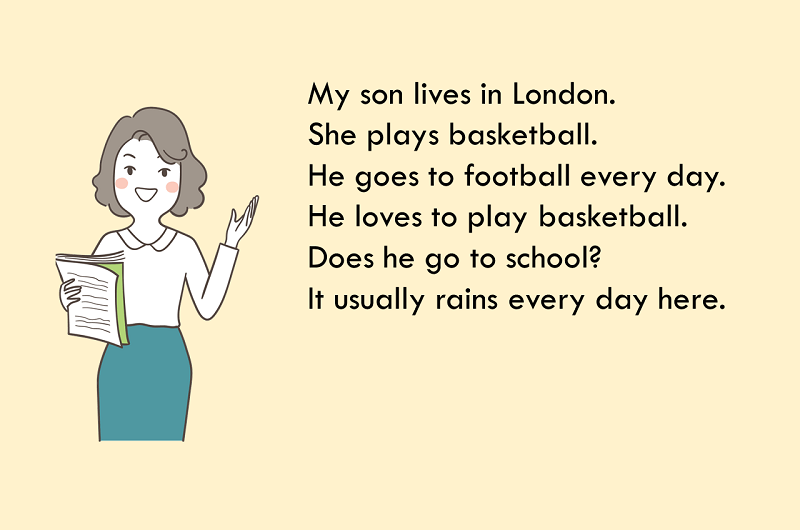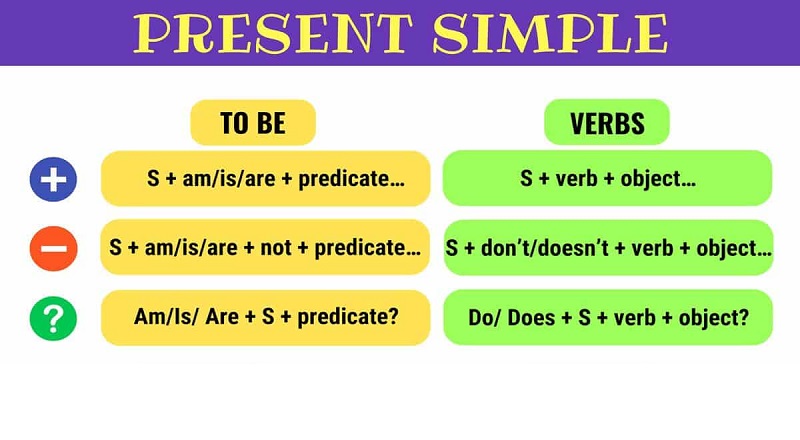Với bài viết hôm nay, IELTS Cấp tốc mời các em học sinh lớp 4 cùng xem lại phần ngữ pháp tiếng Anh về Thì hiện tại đơn và làm một số bài tập bài tập Thì hiện tại đơn lớp 4 nhỏ để ôn lại kiến thức nhé!

Nội dung chính
Tổng quan về Thì hiện tại đơn
Cấu trúc với động từ To be
Câu khẳng định: S + am/ is/ are + N/ Adj
I + am = I’m
He/ She/ It/ Danh từ số ít/ Danh từ không đếm được + is = he’s / she’s / it’s
You/ We/ They/ Danh từ số nhiều/ Danh từ đếm được + are = You’re / we’re / they’re
Ví dụ: I am a student. (Tôi là học sinh.)
He is short. (Anh ấy thấp.)
They are teachers. (Họ là giáo viên.)
Câu phủ định: S + am/ is/ are + not + N/ Adj
Ví dụ: I am not a student. = I’m not … (Tôi không phải là học sinh.)
He is not short. = He isn’t … (Anh ấy không thấp.)
They are not teachers. = They aren’t … (Họ không phải là giáo viên.)
Câu nghi vấn:
Hỏi: Am/ Are/ Is (not) + S + N/Adj?
Đáp: – Yes, S + am/ are/ is.
– No, S + am not/ aren’t/ isn’t.
Ví dụ: Are you a teacher?
- Yes, I’m a teacher. / Yes, I am.
- No, I’m not a teacher. / No, I am not.
Ví dụ: Is he short?
- Yes, he’s short. / Yes, he is.
- No, he’s not short. / No, he isn’t.
Cấu trúc với động từ thường
Câu khẳng định: S + V-infinitive
- I/ We/ You/ They/ Danh từ số nhiều + V1
Ví dụ: I go to school by bike. (Tôi đến trường bằng xe đạp)
We like English. (Chúng tôi thích môn tiếng Anh)
- He/ She/ It/ Danh từ số ít/ Danh từ không đếm được + V1 (s/es)
Ví dụ: He goes to school by bike. (Cậu ta đến trường bằng xe đạp)
She likes English. (Cô ta thích môn tiếng Anh)
The Sun sets in the West. (Mặt trời lặn ở hướng Tây)
Câu phủ định: S + do/ does + not + V1 không chia s/es
“do”, “does” là các trợ động từ
do not = don’t
does not = doesn’t
- I don’t go to school by bus. (Tôi không đến trường bằng xe buýt)
- We don’t like Math. (Chúng tôi không thích môn Toán)
- He doesn’t go to school by bus. (Anh ta không đến trường bằng xe buýt)
- She doesn’t like Math. (Cô ta không thích môn Toán)
Chú ý: Sau do/does và don’t/doesn’t thì ta không chia hay thêm s/es vào động từ
She doesn’t likes Math. (Sai vì đã có “doesn’t” mà động từ “like” vẫn có đuôi “s”)
Câu đúng: She doesn’t like Math.
Câu nghi vấn Yes/No:
Hỏi: Do/ Does (not) + S + V1 không chia s/es ?
Đáp: – Yes, S + do/ does.
– No, S + don’t/ doesn’t.
Ví dụ: Do you go to school by bus?
- Yes, I do. / Yes, I go to school by bus.
- No, I don’t. / No, I don’t go to school by bus.
Does she like Math?
- Yes, she does. / Yes, she likes Math.
- No, she doesn’t. / No, she doesn’t like Math.
Câu nghi vấn sử dụng từ hỏi bắt đầu bằng Wh-
WH- questions là các câu hỏi thường được bắt đầu với các từ để hỏi như Who (Ai), What (Cái gì), Which (Cái nào), Whose (Của ai), Where (Ở đâu), When (Khi nào), Why (Tại sao) và How (Thế nào).
| Động từ to be | Động từ thường | |
| Công thức | Wh- + am/ are/ is (not) + S + N/Adj? | Wh- + do/ does (not) + S + V1+…? |
| Ví dụ | – Where are you from? (Bạn đến từ đâu?)– Who are they? (Họ là ai?) | – Where do you come from? (Bạn đến từ đâu?) – What do you do? (Bạn làm nghề gì?) |
Cách sử dụng và dấu hiệu nhận biết
Thì hiện tại đơn được sử dụng để:
• Nói về một thói quen lặp đi lặp lại hàng ngày: I always get up at 6.am.
• Nói về sự thật, chân lý hiển nhiên: The sun sets in the west.
• Nói về khả năng của ai đó: She plays basketball very well.
• Trong cách sử dụng thì hiện tại đơn thường xuất hiện các trạng từ chỉ tần suất cơ bản như: always, usually, often, sometimes, rarely, every day, once a month, in the morning, once in a blue moon…
Để nhận biết thì hiện tại đơn, nên chú ý đến một số trạng từ chỉ tần suất:
- Always (luôn luôn)
- Usually (thường xuyên)
- Often/ Frequently/ Regularly (thường xuyên)
- Sometimes (thỉnh thoảng)
- Seldom/ Rarely/ Hardly (hiếm khi)
- Never (không bao giờ)
Một số cụm từ xuất hiện trong câu sử dụng thì hiện tại đơn:
Every + khoảng thời gian (every month,…)
Once/ twice/ three times/ four times + khoảng thời gian (once a week,..)
In + buổi trong ngày (in the morning,…)
Bài tập Thì hiện tại đơn lớp 4

Bài 1: Choose the correct answer
1. Do you _____ chocolate milk?
- like
- likes
- be like
2. He _____ not want to go to the cinema.
- do
- does
- is
3. He often ____________.
- plays tennis
- wanted breakfast
- walk home
4. It _____ a beautiful day today.
- is
- are
- am
5. Sorry, she _____ not here.
- am
- is
- be
6. They ____________ every day.
- go to school
- swimming at the beach
- on holiday
7. Robert _____ not go to my school.
- is
- does
- are
8. My parents _____ in the city.
- live
- lives
- are live
9. We _____ Vietnamese.
- do be
- are
- do are
10. You _____ happy!
- am
- is
- are
Bài 2: Choose the correct option
1. Bob always drink / drinks tea in the morning.
2. What do / does she like / likes?
3. My sister don’t / doesn’t play tennis.
4. They often visit / visits their grandparents at weekends.
5. We sometimes go / goes to the ice rink.
6. Where do / does your parents come / comes from?
7. Do / Does you want / wants to go home?
8. I don’t / doesn’t watch television after school.
Bài 3: Complete the sentences with the Present Simple form of the given verbs
- Who ________ Sally _________ in Spain? (visit)
- She ________ her aunt and uncle. (visit)
- ________ Tom ________ to school by bus? (go)
- No, he doesn’t. He ________ to school on foot. (go)
- What ________ she ________ on TV? (watch)
- She ________ the news but she ________ soap operas. (watch) (not watch)
- ________ they ________ swimming? (like)
- Yes, they do, but they ________ running. (not like)
- When ________ you ________ to a football match? (go)
- I ________ to a football match on Sundays. (go)
Bài 4: Read and fill in the blank with the Present Simple form of the verbs
“The Smurfs” 1. _________ (be) a cartoon from the ‘80s. The Smurfs 2. ________(live) in a village and Papa Smurf 3. ________(be) their leader. He 4. __________(not wear) a white hat as the other smurfs: his hat 5. ________(be) red. He 6. _________(play) the piano. Brainy Smurf and Jokey Smurf___________(play) the guitar. Brainy often 7. _____________(think) he is the most intelligent Smurf in the village, but he 8. __________(be) usually wrong. He always 9. __________(wear) a pair of glasses and a white hat. Jokey 10. ____________(be) the funny Smurf. He 11. ____________(enjoy) playing tricks on the other Smurfs. Harmony Smurf 12. ____________(love) to play the trumpet, but he 13. ___________(not do) it well. Smurfette 14. __________(not be) the only female Smurf in the village: there 15. ____________(be) other two girls. She 16. __________(have) long blond hair and big eyes. In the picture, she 17. ________(not play) any instrument.
Bài 5: Read and answer the questions
Mary is a musician. She’s tall and beautiful. She works in a studio and a concert hall. She plays the piano. Every day she gets up at nine o’clock in the morning. She takes a shower and gets dressed. She drinks a cup of tea and eats some toast. At ten o’clock, she takes a taxi to the studio.
In the studio, she plays the piano. She writes new songs and makes CDs. At one o’clock, she goes to the restaurant. She eats lunch with her friends. At three o’clock, she goes to the studio again. She plays more music and sings. At six o’clock, she goes home and has dinner.
She goes to the concert hall at eight o’clock. She plays her music for lots of people. They like her songs. She goes home at eleven o’clock. She is very tired and she goes to bed at half past eleven.
- What’s her name?
- Where does she work?
- Does she drink coffee in the morning?
- When does she eat lunch?
- Does she sing in the studio?
- Where does she have dinner?
- When does she go to the concert hall?
- What time does she go to bed?
Đáp án
Bài 1
1. like
2. does
3. plays tennis
4. is
5. is
6. go to school
7. does
8. live
9. are
10. are
Bài 2
1. Bob always drink / drinks tea in the morning.
2. What do / does she like / likes?
3. My sister don’t / doesn’t play tennis.
4. They often visit / visits their grandparents at weekends.
5. We sometimes go / goes to the ice rink.
6. Where do / does your parents come / comes from?
7. Do / Does you want / wants to go home?
8. I don’t / doesn’t watch television after school.
Bài 3
- does – visit
- visits
- Does – go
- goes
- does – watch
- watches – doesn’t watch
- Do – like
- don’t like
- do – go
- go
Bài 4
- Is
- Live
- Is
- Doesn’t wear
- Is
- Plays
- Thinks
- Loves
- Wears
- Is
- Enjoys
- Loves
- Doesn’t do
- Isn’t
- Are
- Has
- Doesn’t play
Bài 5
- Her name is Mary.
- She works in a studio and a concert hall.
- No, she doesn’t.
- She eats lunch at one o’clock.
- Yes, she does.
- She has dinner at home.
- She goes to the concert hall at eight o’clock.
- She goes to bed at half past eleven.
Hy vọng với phần ôn lại kiến thức cũng như hoàn thành các bài tập Thì hiện tại đơn lớp 4 (Present Simple tense), IELTS Cấp tốc đã giúp các em học sinh lớp 4 nắm vững hơn về cách sử dụng thì này trong tiếng Anh. Chúc các em học tốt!

